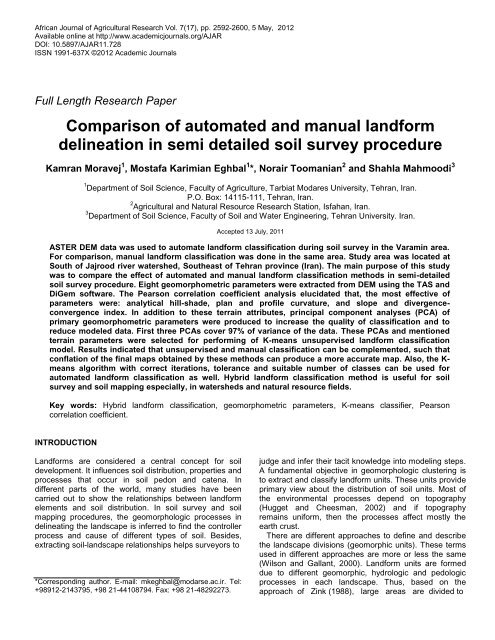Download Complete Issue - Academic Journals
Download Complete Issue - Academic Journals
Download Complete Issue - Academic Journals
Create successful ePaper yourself
Turn your PDF publications into a flip-book with our unique Google optimized e-Paper software.
African Journal of Agricultural Research Vol. 7(17), pp. 2592-2600, 5 May, 2012<br />
Available online at http://www.academicjournals.org/AJAR<br />
DOI: 10.5897/AJAR11.728<br />
ISSN 1991-637X ©2012 <strong>Academic</strong> <strong>Journals</strong><br />
Full Length Research Paper<br />
Comparison of automated and manual landform<br />
delineation in semi detailed soil survey procedure<br />
Kamran Moravej 1 , Mostafa Karimian Eghbal 1 *, Norair Toomanian 2 and Shahla Mahmoodi 3<br />
1 Department of Soil Science, Faculty of Agriculture, Tarbiat Modares University, Tehran, Iran.<br />
P.O. Box: 14115-111, Tehran, Iran.<br />
2 Agricultural and Natural Resource Research Station, Isfahan, Iran.<br />
3 Department of Soil Science, Faculty of Soil and Water Engineering, Tehran University. Iran.<br />
Accepted 13 July, 2011<br />
ASTER DEM data was used to automate landform classification during soil survey in the Varamin area.<br />
For comparison, manual landform classification was done in the same area. Study area was located at<br />
South of Jajrood river watershed, Southeast of Tehran province (Iran). The main purpose of this study<br />
was to compare the effect of automated and manual landform classification methods in semi-detailed<br />
soil survey procedure. Eight geomorphometric parameters were extracted from DEM using the TAS and<br />
DiGem software. The Pearson correlation coefficient analysis elucidated that, the most effective of<br />
parameters were: analytical hill-shade, plan and profile curvature, and slope and divergenceconvergence<br />
index. In addition to these terrain attributes, principal component analyses (PCA) of<br />
primary geomorphometric parameters were produced to increase the quality of classification and to<br />
reduce modeled data. First three PCAs cover 97% of variance of the data. These PCAs and mentioned<br />
terrain parameters were selected for performing of K-means unsupervised landform classification<br />
model. Results indicated that unsupervised and manual classification can be complemented, such that<br />
conflation of the final maps obtained by these methods can produce a more accurate map. Also, the Kmeans<br />
algorithm with correct iterations, tolerance and suitable number of classes can be used for<br />
automated landform classification as well. Hybrid landform classification method is useful for soil<br />
survey and soil mapping especially, in watersheds and natural resource fields.<br />
Key words: Hybrid landform classification, geomorphometric parameters, K-means classifier, Pearson<br />
correlation coefficient.<br />
INTRODUCTION<br />
Landforms are considered a central concept for soil<br />
development. It influences soil distribution, properties and<br />
processes that occur in soil pedon and catena. In<br />
different parts of the world, many studies have been<br />
carried out to show the relationships between landform<br />
elements and soil distribution. In soil survey and soil<br />
mapping procedures, the geomorphologic processes in<br />
delineating the landscape is inferred to find the controller<br />
process and cause of different types of soil. Besides,<br />
extracting soil-landscape relationships helps surveyors to<br />
*Corresponding author. E-mail: mkeghbal@modarse.ac.ir. Tel:<br />
+98912-2143795, +98 21-44108794. Fax: +98 21-48292273.<br />
judge and infer their tacit knowledge into modeling steps.<br />
A fundamental objective in geomorphologic clustering is<br />
to extract and classify landform units. These units provide<br />
primary view about the distribution of soil units. Most of<br />
the environmental processes depend on topography<br />
(Hugget and Cheesman, 2002) and if topography<br />
remains uniform, then the processes affect mostly the<br />
earth crust.<br />
There are different approaches to define and describe<br />
the landscape divisions (geomorphic units). These terms<br />
used in different approaches are more or less the same<br />
(Wilson and Gallant, 2000). Landform units are formed<br />
due to different geomorphic, hydrologic and pedologic<br />
processes in each landscape. Thus, based on the<br />
approach of Zink (1988), large areas are divided to

















